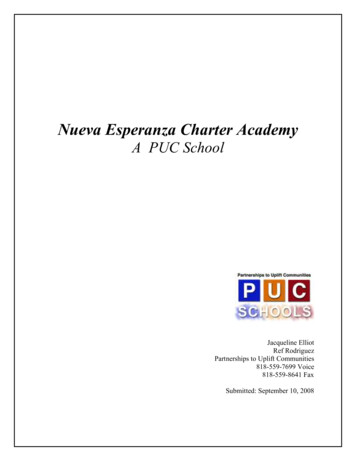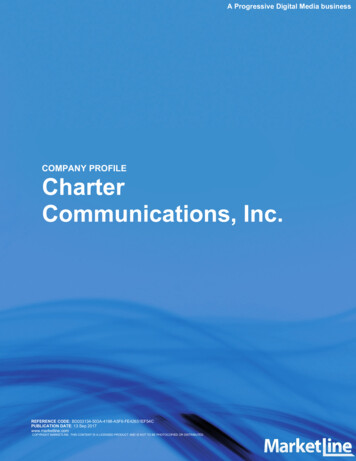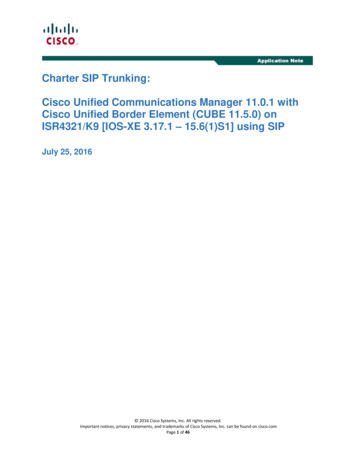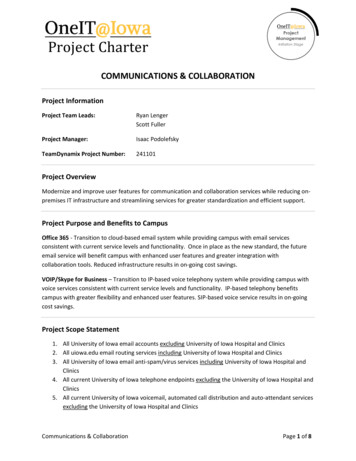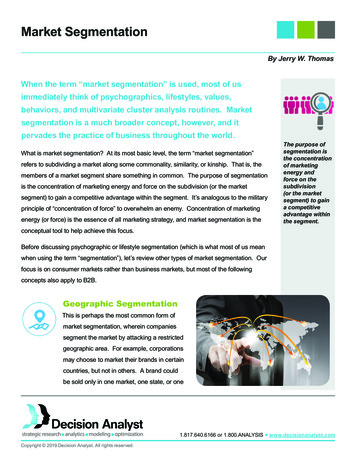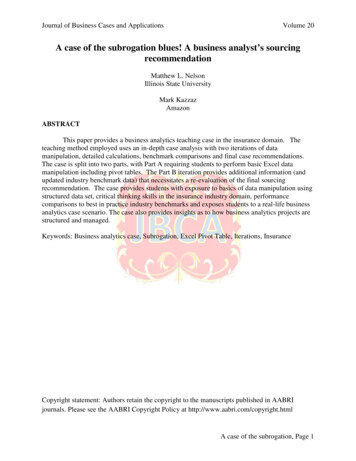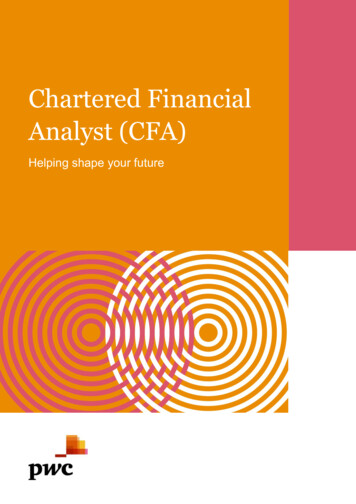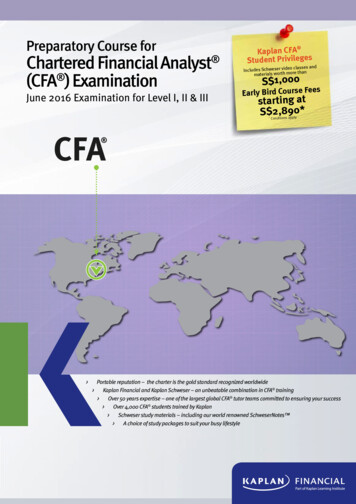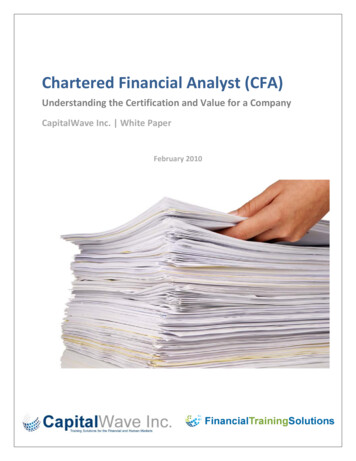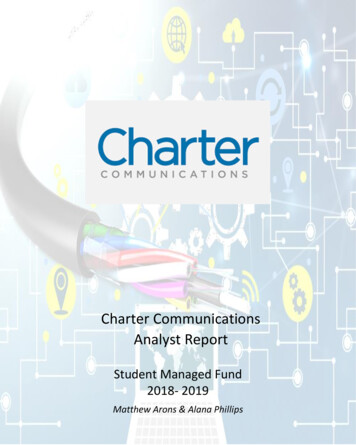
Transcription
Charter CommunicationsAnalyst ReportStudent Managed Fund2018- 2019Matthew Arons & Alana Phillips
Table of ContentsReport Highlights . 1Basis for Recommendation . 1Business Description . 1Acquisitions . 3Industry Overview and Trends . 4Investment Thesis . 5Thesis . 5Catalysts . 5Valuation .6Risks to Investment Thesis. 7Conclusion . 7Appendix . 10
Report HighlightsCharter Communications, Inc. (NYSE: CHTR)Sector: TelecommunicationsPurchasePrice 353.54CurrentPriceTargetPrice 366.76 415.4852-WeekRange 370 250.10MarketCapP/E 92.74 B57.5DividendYieldN/ABeta1.10BASIS FOR RECOMMENDATIONFigure 1: CHTR vs. SPX Return13012512011511010510095908580We recommend a Buy rating for Charter (CHTR) based ona price target of 415.48, resulting in a margin of safety of16.8% given April 26, 2019’s share price of 100.36. Inaddition to some key catalysts, our recommendation isdriven by three long-term factors:CHTR1. Broadband & Subscriber Superiority – Chartershould be able to maintain market-share gains andrevenue growth on its superior broadband speedscompared with telecom, as well as a shift of TimeWarner Cable and Bright House subscribers to itsSpectrum-brand pricing and packaging. Moreover,while cord-cutting is a long-term industry threat, aboost in data subscriptions helps offset video losses.SPX IndexFigure 2: Revenue by Segment4%5%2%Video40%14%High-speed InternetCommercialTelephoneAdvertising sales35%Other2. Mobile Growth & 5G Networks– Over the longerterm, Charter expects consumer savings from theirmobile offering to drive incremental cable becomea more powerful retention tool. In addition, Charterhas the capacity critical to the success of 5G,which relies heavily on fiber networks.3. Increasing Synergy Among Acquisitions– WithFigure 3: Number of 00020,00011,40012,13512,84810,0000FY 2013 FY 2014 FY 2015 FY 2016 FY 2017 FY 2018the integration of its most recent acquisitions (TimeWarner Cable/Bright House Networks) well underway,we believe Charter stands to benefit from increasedscale and significant cost synergies, driving strongfree cash flow growth and shareholder value.BUSINESS DESCRIPTIONCharter is the second largest cable operator in the United States and aleading broadband communications services company providingvideo, Internet and voice services to approximately 28.1 millionresidential and small and medium business customers. Charter recentlylaunched the Spectrum mobile service to residential customers. Inaddition, they sell video and online advertising inventory to local,regional and national advertising customers and fiber-deliveredcommunications and managed information technology (“IT”) solutionsto large enterprise customers. Charter also owns and operates regionalsports networks and local sports, news and community channels.1
Figure 6: Subscribers by ,0005000Figure 5: Video Revenue 9 2010 2011 2012 2013 2014 2015 2016 2017 2018Figure 5: Internet Revenue (Billions)1614121086420FYFYFYFYFYFYFYFYFYFY2009 2010 2011 2012 2013 2014 2015 2016 2017 2018Figure 6: Internet Speed ComparisonProducts and Services Charter offers customers subscription-basedvideo services, including video on demand “VOD”, high definition“HD” television, and digital video recorder “DVR” service, Internetservices, voice and mobile services. As of December 31, 2018,Charter eliminated the carriage of analog video signals ("all-digital")in nearly all of our footprint, further freeing up network capacity andenabling them to offer more HD channels, faster Internet speeds andbetter video picture quality.Video, Internet, and voice services offered are to residential andcommercial customers on a subscription basis, with prices and relatedcharges based on the types of service selected, whether the servicesare sold as a “bundle” or on an individual basis and the equipmentnecessary to receive our services. Bundled services are available tosubstantially all of their passing’s, and approximately 58% of theircustomers subscribe to a bundle of services including video, Internetand voice.Video Services Video customers receive a package of programmingwhich generally includes a digital set-top box that provides aninteractive electronic programming guide with parental controls,access to pay-per-view services, including VOD, digital musicchannels and the option to view certain video services on third-partydevices. Customers have the option to purchase additional tiers ofservices including premium channels, which provide originalprogramming, commercial-free movies, sports, and other specialevent entertainment programming.Internet Services Spectrum pricing and packaging “SPP” offers anentry level Internet download speed of at least 100 megabits persecond (“Mbps”) in 99% of their footprint and 200 Mbps acrossapproximately 40% of their footprint.Additionally, leveraging DOCSIS 3.1 technology, they offer 940Mbps speed service ("Spectrum Internet Gig") in nearly 60% oftheir entire footprint. Charter also offers a security suite with ourInternet services, which, upon installation by customers, providesprotection against computer viruses and spyware and includesparental control features. Additionally, Charter offers an out-ofhome WiFi service, Spectrum Wi-Fi, to their Internet customers atdesignated “hot spotsVoice Services Charter provides voice communications servicessing voice over Internet protocol "VoIP" technology to transmitdigital voice signals over our network. Voice services includeunlimited local and long distance calling to the United States,Canada, Mexico and Puerto Rico, voicemail, call waiting, caller ID,call forwarding and other features and offers international callingeither by the minute, or through packages of minutes per month. Forcustomers that subscribe to both voice and video offerings, caller IDon TV is also available in most areas.2
Figure 8: Brighthouse and TWC LogoMobile Services At the end of the second quarter of 2018, Charterlaunched their mobile product, Spectrum Mobile, to residentialcustomers under a MVNO reseller agreement with Verizon and beganmass-market advertising of Spectrum Mobile service in September2018. Spectrum Mobile is currently available to residential Internetservice customers and Charter will begin to offer the mobile serviceto all of their small and medium business customers on similar termsin 2019. We believe Spectrum-branded mobile services will drivemore sales of our core products, create longer customer lives andincrease profitability and cash flow over time. Charter is leveragingtheir WiFi network in conjunction with additional unlicensed orlicensed spectrum to improve network performance and expandcapacity to offer consumers a superior mobile service at a lower totalcost. Most exciting, they have experimental wireless licenses from theFederal Communications Commission ("FCC", which they areutilizing to test next generation mobile services in several serviceareas around the country.Figure 9: Time Warner Cable Valuation ACQUISITIONSBright House Networks and Time Warner CableAt the time of combination, Bright House Networks was the sixthlargest owner and operator of cable systems in the U.S. and thesecond largest in Florida, with technologically advanced systemslocated in five states including Florida, Alabama, and Indiana,Michigan and California and two of the top 20 DMAs. Moreover,Time Warner Cable Inc. was among the largest providers ofvideo, high-speed data and voice services in the United States,connecting 15 million customers to entertainment, informationand each other.Figure 10: New Charter post-MergerThe combination of Charter, Time Warner Cable and Bright House isnow a leading broadband services and technology company serving23.9 million customers in 41 states. These investments by Charter havedriven investment into the combined entity's advanced broadbandnetwork, allowed for wider deployment of new competitive facilitiesbased WiFi networks in public places, and expanded the footprintexpansion of optical networks to serve the large marketplace of smalland medium sized businesses.Moreover, the merger has resulted in faster broadband speeds, bettervideo products, including more high definition channels, moreaffordable phone service and more competition, for consumers andbusinesses. The scale of the new entity has also resulted in greaterproduct innovation, bringing new and advanced services to consumersand businesses, including Charter's Spectrum Guide and World Boxand other product innovations.3
Industry Overview and TrendsFigure 11: Telecommunications ETF vs.CHTR12512011511010510095908580From our perspective, there are three mega-trends influencingcommunication services companies' growth, margins, and returns,which we believe should drive earnings and stock prices in 2019 andover the long term.The first trend is convergence. To compete for customerengagement, companies are overlapping on more fronts than everbefore. For example, America’s largest phone company, AT&T,now owns cable network HBO. With its recent acquisition of TimeWarner, and its ownership of DirecTV, AT&T is now producingand distributing content. Comcast and Charter Communications arenow selling mobile phone services. With 5G on the horizon, somehouseholds will be able to purchase home broadband wirelessly.CHTRIYZ ETFFigure 12: High-Speed DataSubscribers 96150000VerizonAT&TComcastCharterFigure 13: U.S Cable Revenue(Millions)140000130000120000The second major theme is digitalization. Broadband has been akey cable growth area with subscriptions rising 6% a year withhigh-speed data demand reaching new highs. Some telecomcompany networks are now seeing as much traffic in one hour asthey did in an entire week less than a decade ago. Total Cable HSDsubscribers were 68.2 million in 2018 and are expected to rise to70.7 million in 2022. As unlimited data plans are now the standard,people are using more broadband without paying more, unlike theydo with electricity or fuel. Moreover, residential voice serviceshave witnessed a significant decline in revenues due to theincreasing usage of wireless voice services. In addition, growingconsumer preference for digital and subscription services instead oflinear pay-tv and rental or outright purchase has compelled industryparticipants to alter their business models. U.S Broadband OnlySubscribers has increased from 17.4 million to 22.2 million in 2018and is expected to continue to rise.The third mega-trend is scale. Fewer than 5 years ago, having 25million video subscribers or 100 million wireless subscribers wasconsidered massive, but that's not the case in today’s termsGlobalization is playing a big part in scale, and the internet hasbroken down barriers to reaching customers. Where we stand today,just over half the world is online but fewer have a smartphone. So,there remains a large untapped market, and new consumer bases willbe mobile first and in some cases, mobile only. Companies that aregeographically constrained or do not have a direct-to-consumerrelationship over mobile are falling behind in scale.11000010000090000800002010 2011 2012 2013 2014 2015 2016 2017 20184
Investment ThesisFigure 14: Average High Speeds DataMonthly Costs in 5G Home Markets 90 75 60 45 30 15 -Figure 15: Internet Gig MapTHESISCharter has now largely completed the formidable task ofconsolidating three large cable companies; legacy CharterTimeWarner Cable, and Bright House. Charter’s state-of-the-art, fiber-richnetwork is superior in its ability to deliver fast and reliable internet tomillions of consumers across the country. Thus, Charter should be ableto maintain market-share gains and revenue growth on its superiorbroadband speeds compared with telecom, as well as a shift of TimeWarner Cable and Bright House subscribers to its Spectrum-brandpricing and packaging. Lastly, the new entity resulted in greaterproduct innovation, and brought new and advanced services toconsumers and businessesCATALYSTSBroadband & Subscriber SuperiorityStarting speed of Spectrum Internet is at least 100 Mbps in morethan 99 percent of the communities. Currently all digital in nearlytheir entire footprint. Moreover, their all-digital platform enablesfaster Internet speeds and better picture quality while providinggreater plant security and enabling lower installation and disconnectservice truck rolls. Spectrum has now rolled out gigabit connectionsfeaturing DOCSIS 3.1 internet services to approximately 23 millionU.S. homes, with plans to span this service to virtually the entire 41state footprint in 2019Mobile Growth & 5G NetworksFigure 16: Cable Fiber CoverageCharter will be able leverage its network assets for 5G, since itsdense last-mile network will form the backbone for small cellsneeded in 5G deployment. Deep Fiber not only allows cable todeliver broadband speed upgrades, but also strengthens backhaulcapabilities to grow denser. (Spectrum Mobile is Charter’s most recent ambition has the capacityto strengthen their ability to retain customers long-term. Launched in2018, a hybrid MVNO provider that uses WIFI and Verizon’sWireless Network (America’s Largest LTE network) to provideservice. Customers can benefit from obtaining advanced servicesfrom a single provider simplifying procurement and potentiallyreducing their costs.The main competitive advantage Charter can offer through themobile service is a lower total cost.5
Figure 17: Verizon 4G LTE CoverageFigure 18: Mobile Subscriber’sAnalysis (000’s)Using Wi-Fi network in conjunction with additional unlicensedor licensed spectrum improves network performance and expandscapacity to offer consumers a superior mobile. The success sincethe launch has been exceptional. Charter has added over 110,000mobile lines in the fourth quarter.Over the longer term, consumer savings from mobile offeringwill drive incremental cable sales and become a more powerfulretention tool. Another big catalyst for Spectrum Mobile will be“Full Bring Your Own Device” availability. Spectrum Mobilenow allows customers to bring their own iPhone as long as it isone of the following models; iPhone SE, iPhone 6S or 6S Plus,iPhone 7 or 7 Plus, iPhone 8 or 8 Plus, or the iPhone X. In 2019,Charter will be able to carry the newest IPhone’s (Xs and XsMax) and word Android devices, which will expand mobilemarket opportunity substantially.Increasing Synergy among Acquisition’s30002500After the merger, the new entity resulted in greater productinnovation, and brought new and advanced services to consumersand businesses. Capital intensity will fall significantly in 2019, asplanned, but also beyond 2019. We anticipate this trend because asCPE spend per home declines, consumers increasingly install theirown services and the reliability of plant’s improve. We also expectCharter’s network becomes increasingly cloud-based and IP driven.200015001000500020182019E 2020E 2021E 2022E 2023EMoreover, the transaction structure was designed to provide longdated and low-cost financing, and enable unified operations, whichachieves operating cost and tax objectives.ValuationFigure 19: DCF ModelCharter was purchased on March 14, 2018 for 353.34 per share.At the time of pitch, our valuation resulted in a 17.6% margin ofsafety. Since then, has gained 4.76%. We still believe the stock istrading below its intrinsic value of 415.48DISCOUNTED CASH FLOW MODELFor the Discounted Cash Flow (DCF) model, we assumed totalrevenue growth rate of 6.0% in 2019 and 2020 and decreased to 5%for the following 3 years. This was based on historic growth and aswell as projected subscriber and penetration rates (Appendix E).Next, for terminal growth, we used a 2.5% growth rate, whichaccounts for the rate of the U.S economy. Additionally, we used aWACC of 8.0%, reflective of Charters strategic use of leverage(4.5x) and a cost of debt of 5.0% From the DCF, we arrived at aprice target of 415.48.6
Risks to Investment ThesisFigure 24: U.S Broadband OnlySubscribers 2Q171Q182Q183Q18Figure 25: Programming Charter Communications operates in a very competitive businessenvironment, which affects its ability to attract and retain newcustomers. Although, their merger with Spectrum and Bright Househas successfully allowed them to gain more market share. Charter’sfootprint predominantly overlaps with AT&T Fiber ( 6%) andVerizon Fios ( 5%). While those carriers have neared the end oftheir fiber-fed TV rollouts, their penetration is still relatively low vs.our long-term expectationsIncreasing Programming Costs60004000Cord CuttingAs the proliferation of online video services grows, however,services from V-MVPDs and new direct to consumer offering couldnegatively affect the growth of their video business. (“V-MVPD”)such as DirecTV NOW, Sling TV and Hulu Live, and direct toconsumer products offered by programmers that have nottraditionally sold programming directly to consumers, such as HBONow, CBS All Access and Showtime Anytime. Subscription videoon demand (“SVOD”) services such as Netflix, Amazon Prime, andHulu Plus YouTube and Hulu are further threats.Highly Competitive Market20172018In addition, programming costs are rising at a much faster rate thanwages or inflation, and they may not have the ability to reduce ormoderate the growth rates or, or pass on to their customers.Increases in the cost of sports programming and the amounts paidfor broadcast station retransmission consent have been the largestcontributors to the growth in our programming costs over the lastfew years. Additionally, the demands of large media companieswho link carriage of their most popular networks to carriage andcost increases of their less popular networks, has limited Charter’sflexibility in creating more tailored and cost-sensitive programmingpackages for consumers.7
Appendix
Appendix A: ManagementCharter’s management team is composed of individuals with a wide range of experience in thetelecommunications industry. The team is dedicated to creating the best intellectual property and fostering anenvironment of creativity and innovation. Thomas Rutledge is the company’s Chairman, CEO, and prior tobecoming CEO of Charter in 2012, Mr. Rutledge, a 42-year veteran of the industry, served as Chief OperatingOfficer of Cablevision Systems. His vision for the company consists of three concepts: fostering innovation andapplying the latest technology, generating the best content, and expanding to new markets across the world.Thomas M. RutledgeChairman and CEOThomas E. AdamsEVP, Field OperationsJohn BickmanPresident and COOMichael BlairEVP, Spectrum NetworksDavid G. EllenSenior Executive VicePresidentJames BlackleyEVP, Engineering and ITChristopher L.WinfreyCFOD
Canada, Mexico and Puerto Rico, voicemail, call waiting, caller ID, call forwarding and other features and offers international calling either by the minute, or through packages of minutes per month. For customers that subscribe to both voice and video offerings, caller ID on TV is also a
